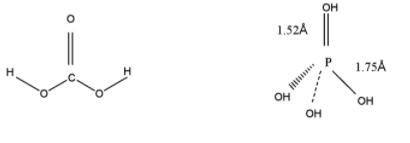
Out of the following, amphiprotic species are:
(I) $HPO_3^{ - 2}$ (II) OH (III) ${H_2}PO_4^ - $ (IV) $HCO_3^ - $
A. I, III, IV
B. I and III
C. III and IV
D. All
Answer
567.3k+ views
Hint: Amphiprotic species behaves as acid as well as base. The species contains both properties, it acts as an amphiprotic species. It must be able to accept hydronium ion or give away also hydronium ion. Amphiprotic species accept a proton or donate away its proton. This can help to determine the difference between amphiprotic and amphoteric.
Complete step by step answer:
Amphiprotic species remove hydrogen ions from an acid or by adding hydrogen ions to a base. It acts as acid as well as base. They contain properties of acid or base.
Amphiprotic species either donate protons or accept protons which depend on their circumstances.
Here, ${H_2}PO_4^ - $ and $HCO_3^ - $ both are amphiprotic species. Both species act as acid as well as base.
Their structure is shown below:

As we see the structure of species which act as acid or base. Both structures are an amphiprotic species.
The bicarbonate act as acid or base in water, which is defined by the following reactions:
\[
HCO_3^ - + {H_2}O \to CO_3^{ - 2} + {H_3}{O^ + } \\
HCO_2^ - + {H_2}O \to {H_2}C{O_3} + O{H^ - } \\
\]
As it is ${H_2}PO_4^ - $ also acts as acid as well as base.
Hence option (C) is the correct.
Note:
Amphiprotic substances can accept or donate at least one proton. So, in order for a substance to be amphiprotic, it must be able to accept proton ions or give away proton ions. These species behave like an acid in basic media and behave like base when present in an acidic medium.
Complete step by step answer:
Amphiprotic species remove hydrogen ions from an acid or by adding hydrogen ions to a base. It acts as acid as well as base. They contain properties of acid or base.
Amphiprotic species either donate protons or accept protons which depend on their circumstances.
Here, ${H_2}PO_4^ - $ and $HCO_3^ - $ both are amphiprotic species. Both species act as acid as well as base.
Their structure is shown below:

As we see the structure of species which act as acid or base. Both structures are an amphiprotic species.
The bicarbonate act as acid or base in water, which is defined by the following reactions:
\[
HCO_3^ - + {H_2}O \to CO_3^{ - 2} + {H_3}{O^ + } \\
HCO_2^ - + {H_2}O \to {H_2}C{O_3} + O{H^ - } \\
\]
As it is ${H_2}PO_4^ - $ also acts as acid as well as base.
Hence option (C) is the correct.
Note:
Amphiprotic substances can accept or donate at least one proton. So, in order for a substance to be amphiprotic, it must be able to accept proton ions or give away proton ions. These species behave like an acid in basic media and behave like base when present in an acidic medium.
Recently Updated Pages
Master Class 12 Business Studies: Engaging Questions & Answers for Success

Master Class 12 Economics: Engaging Questions & Answers for Success

Master Class 12 English: Engaging Questions & Answers for Success

Master Class 12 Maths: Engaging Questions & Answers for Success

Master Class 12 Social Science: Engaging Questions & Answers for Success

Master Class 12 Chemistry: Engaging Questions & Answers for Success

Trending doubts
What is meant by exothermic and endothermic reactions class 11 chemistry CBSE

Which animal has three hearts class 11 biology CBSE

10 examples of friction in our daily life

One Metric ton is equal to kg A 10000 B 1000 C 100 class 11 physics CBSE

1 Quintal is equal to a 110 kg b 10 kg c 100kg d 1000 class 11 physics CBSE

Difference Between Prokaryotic Cells and Eukaryotic Cells




